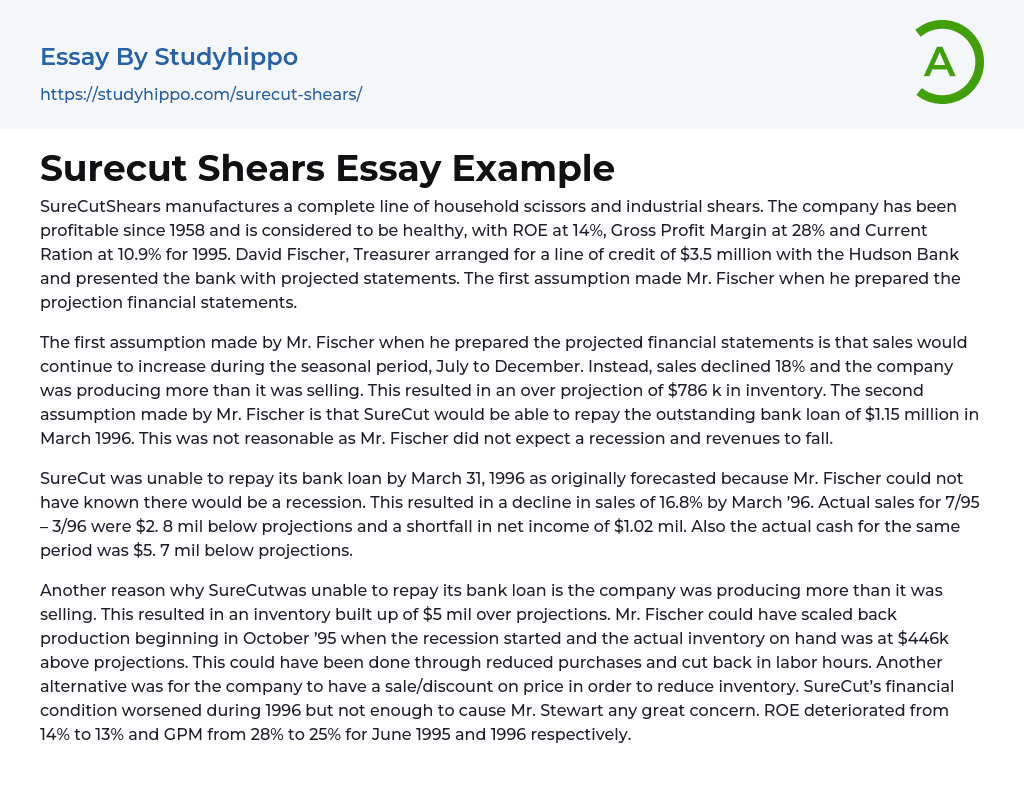SureCutShears manufactures household scissors and industrial shears. The company has been financially successful since 1958, with a Return on Equity (ROE) of 14%, a Gross Profit Margin of 28%, and a Current Ratio of 10.9% in 1995. In order to secure additional funds, the Treasurer, David Fischer, obtained a $3.5 million line of credit from Hudson Bank and presented them with projected financial statements. One key assumption made by Mr. Fischer when developing these projections was that the company's profitability would continue.
Mr. Fischer made two assumptions when preparing the projected financial statements. The first assumption was that sales would continue to increase from July to December, but they actually declined by 18%, causing the company to produce more than it could sell. As a result, the inventory was over projected by
...$786 k. The second assumption was that SureCut would be able to repay their outstanding bank loan of $1.15 million by March 1996.
SureCut's inability to repay its bank loan as projected by March 31, 1996 was a result of Mr. Fischer's lack of foresight regarding the recession. It was unrealistic to expect him to anticipate the economic downturn and subsequent decline in revenues.
In March 1996, there was a decrease of 16.8% in sales, causing the actual sales from July 1995 to March 1996 to be $2.8 million less than expected. Moreover, there was a net income shortfall of $1.02 million and the actual cash for the same period fell short of projections by $5.7 million.
The reason why SureCut could not repay its bank loan is that the company was producing more than it was selling, leading to an inventory buildup of $5 millio
which exceeded projections. Mr. Fischer had the option to start scaling back production in October '95, when the recession began and the actual inventory on hand exceeded projections by $446k. This could have been achieved by reducing purchases and cutting back on labor hours.
Another option for the company was to offer a sale or discount on prices to decrease inventory. SureCut's financial situation declined in 1996, but it did not worry Mr. Stewart greatly. The return on equity fell from 14% to 13%, and the gross profit margin dropped from 28% to 25% for June of both 1995 and 1996.
- Accounts Receivable essays
- Auditor's Report essays
- Balance Sheet essays
- Costs essays
- Financial Audit essays
- International Financial Reporting Standards essays
- Tax essays
- Accountability essays
- Cash essays
- Principal essays
- Management Accounting essays
- Internal Control essays
- Accounting Software essays
- Cash Flow essays
- Commercial Bank essays
- Debit Card essays
- Deposit Account essays
- Subprime Lending essays
- Perfect Competition essays
- Underwriting essays
- Synergy essays
- Valuation essays
- Asset essays
- Depreciation essays
- Discounted Cash Flow essays
- Foreign Direct Investment essays
- Funds essays
- Internal Rate Of Return essays
- Revenue essays
- Day Trading essays
- Futures Trading essays
- Capital market essays
- Million essays
- Payment essays
- Rate Of Return essays
- Funding essays
- Hedge Fund essays
- Accounting essays
- Andrew Carnegie essays
- Automation essays
- Business Cycle essays
- Business Intelligence essays
- Business Model essays
- Business Operations essays
- Business Software essays
- Cooperation essays
- Cooperative essays
- Corporate Social Responsibility essays
- Corporation essays
- Customer Relationship Management essays




